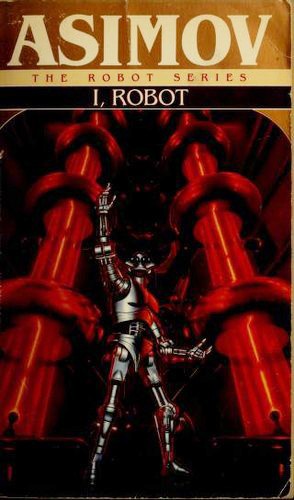jonn reseñó I, Robot de Isaac Asimov (Robot (1))
In Asimov’s work, we see what we know. How many gems are still uncovered?
5 estrellas
The topics in this book that were outstanding for me were parental neglect and bullying children into what parents feel they should do rather than letting them live and experiment. Crushing the psyche. It’s quite cute how psychologic story is also the origin of the psychologist career, good rhyme there.
But time proved Mrs. Weston a bit too optimistic. To be sure, Gloria ceased crying, but she ceased smiling, too, and the passing days found her ever more silent and shadowy. Gradually, her attitude of passive unhappiness wore Mrs. Weston down and all that kept her from yielding was the impossibility of admitting defeat to her husband. Asimov on parental priorities. Very accurate!
Then, I don’t know how popular were wild conspiracy theories in the 40s, but I loved the vignette where one of the experimental roboticists are working with a religious robots:
Powell’s fingers were in his mustache and …
The topics in this book that were outstanding for me were parental neglect and bullying children into what parents feel they should do rather than letting them live and experiment. Crushing the psyche. It’s quite cute how psychologic story is also the origin of the psychologist career, good rhyme there.
But time proved Mrs. Weston a bit too optimistic. To be sure, Gloria ceased crying, but she ceased smiling, too, and the passing days found her ever more silent and shadowy. Gradually, her attitude of passive unhappiness wore Mrs. Weston down and all that kept her from yielding was the impossibility of admitting defeat to her husband. Asimov on parental priorities. Very accurate!
Then, I don’t know how popular were wild conspiracy theories in the 40s, but I loved the vignette where one of the experimental roboticists are working with a religious robots:
Powell’s fingers were in his mustache and his eyes were slitted. “Listen, Cutie, if there is no such thing as Earth, how do you account for what you see through a telescope?”
“Pardon me!”
The Earthman smiled. “I’ve got you, eh? You’ve made quite a few telescopic observations since being put together, Cutie. Have you noticed that several of those specks of light outside become disks when so viewed?”
“Oh, that! Why certainly. It is simple magnification -- for the purpose of more exact aiming of the beam.”“Why aren’t the stars equally magnified then?”
“You mean the other dots. W ell, no beams go to them so no magnification is necessary. Really, Powell, even you ought to be able to figure these things out.”
Powell stared bleakly upward. “But you see more stars through a telescope. Where do they come from? Jumping Jupiter, where do they come from?” Cutie was annoyed. “Listen, Powell, do you think I’m going to waste my time trying to pin physical interpretations upon every optical illusion of our instruments?
Since when is the evidence of our senses any match for the clear light of rigid reason?”
Now we’re getting to the point which makes me rate this book at 4.5 stars instead of mere 4. Asimov has dreamed of prompt injections, which are widespread these days, even though we are in the early days of generative AI. This would be a fantastic idea for us five years ago. Maybe we would say that this is analagous to code injections in IT security, which was known and rampant for many years, but that’s about it.
Now stuff like this happens to tech giants and has to audited for. Obviously, as software is largely decoupled from the hardware, this doesn’t have as lingering of effects as described in the book, but potential input poisoning can render models useless! We’ll see a lot more fun akin to that in the coming years.
The general manager did so with alacrity,
“Here’s the deal now, chief. Consolidated Robots approached us a month ago with a funny sort of proposition. They brought about five tons of figures, equations, all that sort of stuff. It was a problem, see, and they wanted an answer from The Brain. The terms were as follows-- A hundred thousand for us if there is no solution and we can tell them the missing factors. Two hundred thousand if there is a solution, plus costs of construction of the machine involved, plus quarter interest in all profits derived therefrom. The problem concerns the development of an interstellar engine--”
Robertson frowned and his lean figure stiffened, “Despite the fact that they have a thinking machine of their own. Right?”
“Consolidated had a thinking machine. It’s broken. Nobody knows why, but I got hold of some pretty interesting guesses -- like, for instance, that they asked it to give them an interstellar engine with the same set of information they came to us with, and that it cracked their machine wide open.”
Further justifying the 4.5 mark is Asimov’s forewarning of the opacity of complex non-deterministic algorithms, such as the one we see in the modern ML/AI. We know how the models are trained and roughly what the models are doing, but we have no clue how they do what they do!
“And you said, ‘Have your boys check them and make sure, anyway.’”
“Susan, you read my mind. It was what I said, and he said he couldn’t.”
“Too busy?”
“No, he said that no human could. He was frank about it. He told me, and I hope I understand him properly, that the Machines are a gigantic extrapolation. Thus, a team of mathematicians work several years calculating a positronic brain equipped to do certain similar acts of calculation. Using this brain they make further calculations to create a still more complicated brain, which they use again to make one still more complicated and so on. According to Silver, what we call the Machines are the result of ten such steps.”
Asimov was philosophising about the singularity, but a small nudge against this particular work is that he didn’t philosophise enough about the equality. He could dream of a robot president of the world, but failed to dream of a female engineer.
“But you are telling me, Susan, that the ‘Society for Humanity’ is right; and that Mankind has lost its own say in its future.”
“It never had any, really. It was always at the mercy of economic and sociological forces it did not understand -- at the whims of climate, and the fortunes of war. Now the Machines understand them; and no one can stop them, since the Machines will deal with them as they are dealing with the Society, -- having, as they do, the greatest of weapons at their disposal, the absolute control of our economy.”
“How horrible!” “Perhaps how wonderful! Think, that for all time, all conflicts are finally evitable. Only the Machines, from now on, are inevitable!”
I failed to mention an excerpt from the story I have intellectually enjoyed the most. It was the “Little Lost Robot” story. No matter how Asimov wrote Dr. Calvin in the “Liar!”, which was quite a gross read on so many levels, she is probably the smartest character when it comes to deduction among all of the characters.
The way she handled the case of the missing robot in “Little Lost Robot” is stellar and brought me pure intellectual joy. As a mystery genre enjoyer, I can’t help but to attribute forming the taste in the genre to Asimov’s precise deduction writing, reading which I have enjoyed as a kid. Possibly as much as stellar episode writing and acting in ITV’s Poirot and Columbo.
That concludes my review of “I, Robot”. How many Asimov’s gems we missed? Who knows. But also, on how many of these can we act, hindsight aside? Probably not many.



